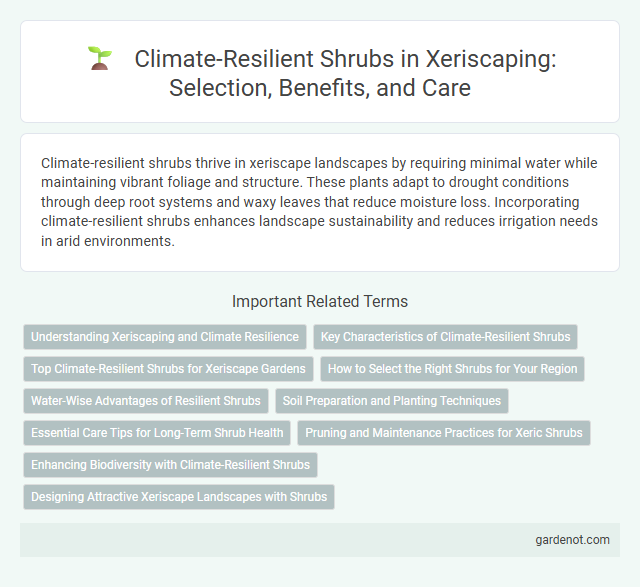Climate-resilient shrubs thrive in xeriscape landscapes by requiring minimal water while maintaining vibrant foliage and structure. These plants adapt to drought conditions through deep root systems and waxy leaves that reduce moisture loss. Incorporating climate-resilient shrubs enhances landscape sustainability and reduces irrigation needs in arid environments.
Understanding Xeriscaping and Climate Resilience
Climate-resilient shrubs in xeriscaping are essential for conserving water while withstanding drought and extreme temperatures commonly found in arid and semi-arid regions. These drought-tolerant plants improve soil stability, reduce erosion, and support local biodiversity by providing habitat and food sources. Selecting native, deep-rooted shrubs with low water requirements enhances landscape sustainability and minimizes irrigation needs, optimizing both ecological and economic benefits.
Key Characteristics of Climate-Resilient Shrubs
Climate-resilient shrubs exhibit deep root systems that enhance water absorption and retention during drought conditions. These shrubs possess waxy or hairy leaf surfaces that reduce water loss through transpiration, ensuring survival in arid climates. Their ability to adapt to fluctuating temperatures and poor soil quality makes them essential for sustainable xeriscaping in water-scarce environments.
Top Climate-Resilient Shrubs for Xeriscape Gardens
Top climate-resilient shrubs for xeriscape gardens include Texas sage, which thrives in arid conditions with minimal water requirements and offers vibrant purple blooms. Bearberry shrub provides drought tolerance along with ground-covering properties, making it ideal for soil erosion control. Desert willow boasts beautiful, trumpet-shaped flowers and adapts well to heat and prolonged dry periods, enhancing both aesthetics and sustainability in xeriscaping.
How to Select the Right Shrubs for Your Region
Selecting climate-resilient shrubs for xeriscaping requires understanding your region's specific temperature ranges, rainfall patterns, and soil types to ensure optimal growth and water efficiency. Native species like manzanita in arid West regions or mountain laurel in the Southeast demonstrate high drought tolerance and adaptability to local microclimates. Prioritize shrubs with deep root systems and proven resilience to regional pests and diseases to maintain sustainable, low-water landscapes.
Water-Wise Advantages of Resilient Shrubs
Resilient shrubs like manzanita and Texas sage thrive in xeriscape gardens due to their deep root systems that maximize water absorption and retention, significantly reducing irrigation needs. These drought-tolerant plants enhance soil stability and minimize erosion while maintaining vibrant foliage and seasonal blooms despite prolonged dry spells. Incorporating climate-resilient shrubs promotes sustainable landscaping by lowering water consumption and supporting local ecosystems adapted to arid climates.
Soil Preparation and Planting Techniques
Selecting climate-resilient shrubs such as Texas sage or desert willow maximizes xeriscaping success by thriving in arid conditions. Effective soil preparation includes amending sandy or clay soils with organic matter to enhance water retention and drainage, crucial for shrub root development. Planting techniques emphasize deep planting and mulching to conserve moisture and protect roots from temperature extremes.
Essential Care Tips for Long-Term Shrub Health
Climate-resilient shrubs such as lavender, sage, and juniper require minimal water and thrive in drought-prone environments by adapting to local soil and sunlight conditions. Regular deep watering during establishment, combined with mulching, reduces evaporation and supports root development for long-term shrub health. Pruning dead or diseased branches annually enhances air circulation and prevents pest infestations, ensuring the shrub's resilience through varying seasonal climates.
Pruning and Maintenance Practices for Xeric Shrubs
Pruning xeric shrubs enhances air circulation, reduces disease risk, and promotes drought tolerance by removing dead or overcrowded branches. Proper maintenance includes seasonal inspection for pests and mulching to retain soil moisture in arid environments. Regular, strategic trimming supports the shrub's natural form, conserving water while encouraging robust growth in climate-resilient landscapes.
Enhancing Biodiversity with Climate-Resilient Shrubs
Climate-resilient shrubs such as Manzanita, Ceanothus, and Woolly Blue Curls thrive in xeriscape gardens by conserving water and supporting native pollinators. These drought-tolerant plants improve soil health and create habitats for birds, insects, and small mammals, significantly enhancing urban biodiversity. Incorporating a diverse array of climate-adapted shrubs promotes ecosystem resilience in arid and semi-arid landscapes.
Designing Attractive Xeriscape Landscapes with Shrubs
Climate-resilient shrubs such as Texas sage (Leucophyllum frutescens) and Manzanita (Arctostaphylos spp.) thrive in xeriscape landscapes due to their drought tolerance and low water requirements. Their deep root systems enhance soil stability and reduce erosion while providing year-round structure and color in arid garden designs. Integrating diverse shrub species promotes ecological balance and minimizes irrigation needs, making xeriscape landscapes sustainable and visually appealing.
Climate-resilient shrub Infographic

 gardenot.com
gardenot.com